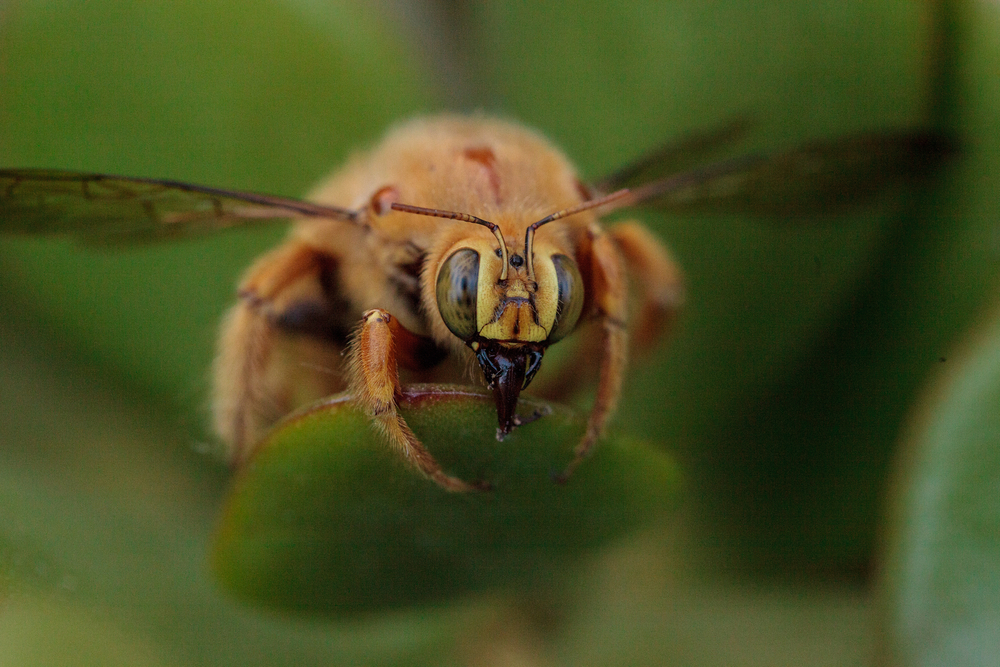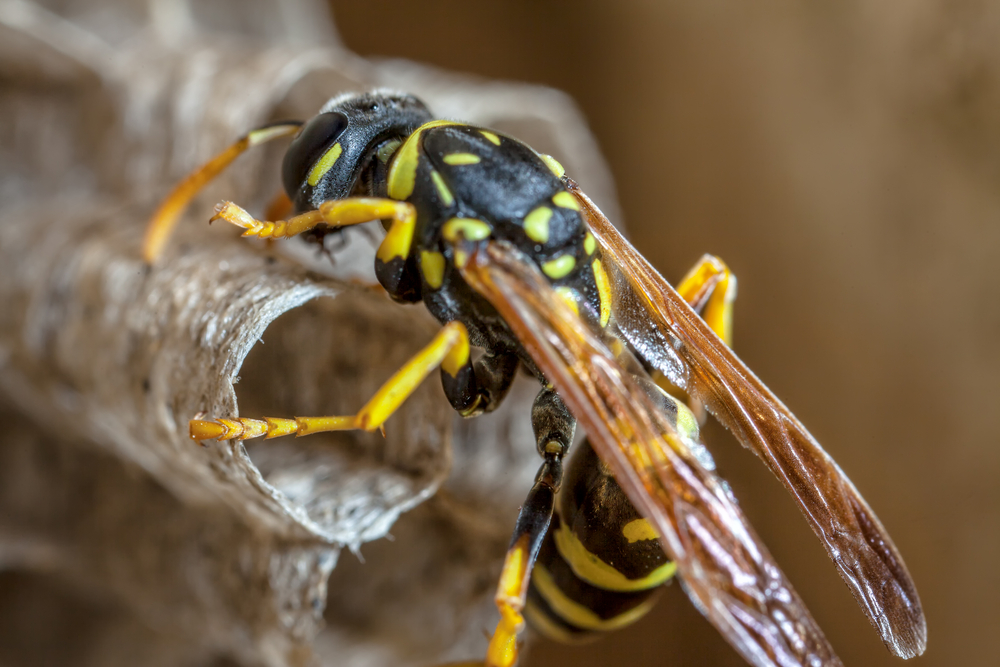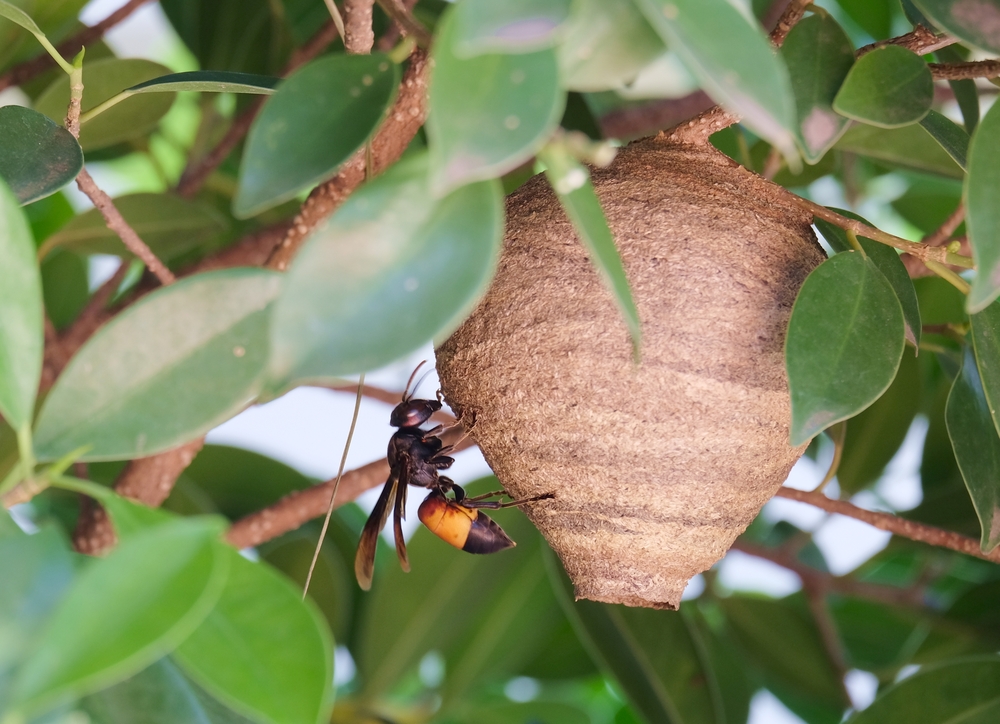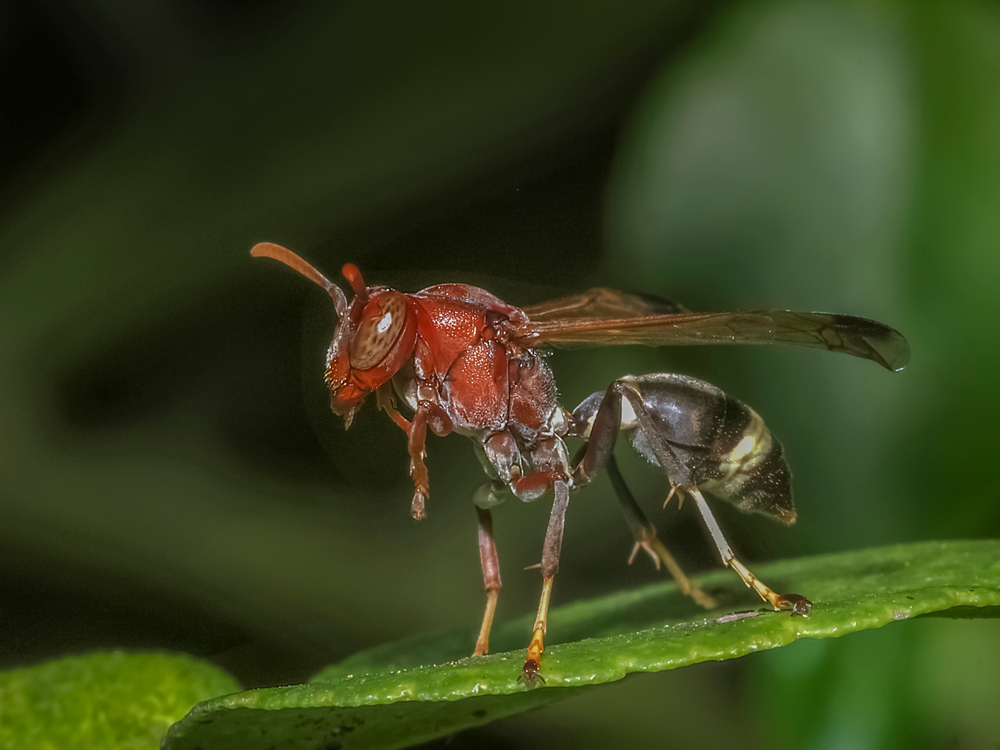There are over 300 recognized species of paper wasps (Polistinae) found worldwide. These species vary in size, coloration, and behavior, with some being more common in certain regions or habitats than others. While there are numerous paper wasp species, they all belong to the same subfamily, Polistinae, which is characterized by their social structure and nest-building behavior.
About
The Paper Wasp, belonging to the family Vespidae and the genus Polistes, represents a fascinating group of insects, renowned for their unique nesting habits and intricate social structures. Nestled within the vast expanse of the Animal Kingdom, these wasps are a part of the class Insecta, showcasing the remarkable diversity and adaptability of this class.
Paper wasps are recognized for their slender bodies, characterized by a narrow waist and long legs, often seen dangling in flight. Their distinct appearance is complemented by the wide range of colors they exhibit, from muted browns to vibrant yellows and reds.
Renowned architects of the insect world, paper wasps skillfully craft their nests from a papery substance they create by mixing saliva and fibers from dead wood and plant stems. These nests, often resembling an upside-down umbrella, are a testament to the wasps’ industrious nature.
Inhabitants of various environments, paper wasps are predominantly found in temperate regions, making their presence known in gardens, orchards, and other human-inhabited areas. Their role extends beyond nest-building; as predators of various pest insects, they are integral to maintaining the ecological balance, highlighting the interconnectedness of life within the Animal Kingdom.
Conservation Concerns
The paper wasps are not specifically assessed by the IUCN Red List, however, their presence contributes to ecosystem health. Habitat loss and pesticide use can indirectly impact their populations by reducing food sources and nesting sites.
Conservation efforts primarily focus on promoting habitat diversity and reducing pesticide use in agricultural and urban areas. Initiatives supporting biodiversity and minimizing habitat destruction indirectly benefit paper wasps and other insect species.
Physical Characteristics
Paper wasps are a group of insects known for their slender and elongated bodies. Here is a description of their physical appearance and characteristics:
Physical Appearance:
- Body Shape: Paper wasps have a distinctive slender and elongated body shape. They have a distinct waist, giving them an hourglass-like appearance.
- Coloration: Their coloration can vary among species but often includes shades of yellow, orange, brown, and black. Some species have red or reddish-brown markings.
- Wings: They have two pairs of membranous wings that are clear or lightly tinted and are held folded longitudinally when at rest.
- Antennae: Paper wasps have long, slender antennae that are usually dark-colored.
- Eyes: Their compound eyes are relatively large and prominent on the sides of their head.
- Stinger: Like other wasps, they possess a stinger at the posterior end of their abdomen, which can deliver painful stings if they feel threatened.
Size:
- Length: The size of paper wasps varies by species, but they typically range from about 0.5 to 1.5 inches (1.3 to 3.8 cm) in length.
- Wingspan: The wingspan of paper wasps can range from 0.75 to 1.5 inches (1.9 to 3.8 cm).
Weight:
- Weight: Individual paper wasps are quite lightweight, usually weighing less than 0.01 ounces (0.3 grams).
It’s important to note that there are many species of paper wasps, and their specific physical characteristics, color patterns, and sizes can vary significantly among these species. Additionally, the size and weight of an individual paper wasp can vary based on factors such as age and nutrition. These wasps are known for their ability to construct paper-like nests from wood fibers, giving them their common name.
Reproduction
Paper wasps, like other social wasps, have a structured reproductive cycle that involves multiple castes within the colony. Here’s an overview of their reproductive behavior:
Colony Structure:
- Paper wasp colonies consist of a queen, workers, and male drones.
- The queen is the reproductive female responsible for laying eggs.
- Workers are sterile females that help with nest construction, foraging, and caring for the young.
- Male drones are produced later in the season for mating purposes.
Mating and Nest Establishment:
- Founding Stage: In early spring, a mated overwintering queen emerges from hibernation. She seeks out a suitable nesting site, often in protected areas such as eaves, tree branches, or other sheltered locations.
- Nest Construction: The queen begins constructing a small paper nest by chewing wood fibers and mixing them with her saliva to create a papery material. She forms hexagonal cells within the nest.
- Egg-Laying: The queen starts laying eggs in the cells. These initial eggs develop into female workers.
- Worker Emergence: The first batch of eggs hatches into larvae, which are fed by the queen. These larvae pupate and emerge as sterile female workers.
- Worker Activities: Workers take over nest building, foraging for food, and caring for subsequent broods.
Egg Production and Castes:
- The queen continues to lay eggs throughout the season.
- In mid to late summer, the queen begins laying eggs that develop into male drones and new queens.
- These future queens and drones will leave the colony to mate with individuals from other colonies.
- Once mated, the new queens seek shelter for overwintering, while the remaining colony members, including the original queen, typically perish as winter approaches.
Gestation and Young:
- Paper wasp eggs have a relatively short gestation period, typically lasting a few days to a week.
- Larvae develop from eggs and undergo metamorphosis into pupae before emerging as adults.
- The number of eggs laid by the queen can vary, but it often depends on the colony’s size and the resources available.
It’s important to note that the specific timing and details of the reproductive cycle can vary among different species of paper wasps. Additionally, paper wasps are known for their aggressive defense of their nests, and their stings can be painful.
Lifespan
The lifespan of paper wasps varies among the different castes within the colony, including queens, workers, and male drones:
- Queen:
- In the Wild: Queens typically live for about one year. They are the longest-lived individuals in the colony and can survive through the winter if they find suitable overwintering sites.
- In Captivity: In captivity, queens may live slightly longer, depending on environmental conditions and care.
- Workers:
- In the Wild: Workers have a shorter lifespan than queens. They typically live for a few months during the active season, from spring to late summer or early fall.
- In Captivity: In captivity, the lifespan of workers can vary but is generally similar to that of wild workers, lasting a few months.
- Male Drones:
- In the Wild: Male drones have the shortest lifespan among paper wasps. They typically live for only a few weeks to a couple of months. Their primary role is to mate with new queens before dying.
- In Captivity: Like workers, the lifespan of male drones in captivity is relatively short and similar to their wild counterparts.
Biggest Threats:
- Predators: Natural predators such as birds, spiders, and other insects may prey on paper wasps, especially foraging workers and drones.
- Parasites: Paper wasp colonies can be susceptible to parasitism by various species of wasp parasitoids that lay their eggs in or near the paper wasp nest. The parasitoid larvae feed on paper wasp larvae or pupae.
- Environmental Factors: Harsh weather conditions, extreme temperatures, or disturbances to the nest can pose threats to paper wasp colonies.
- Human Intervention: When paper wasp nests are located in or near human structures, they may be destroyed or removed by individuals concerned about stings.
It’s important to note that paper wasps are generally not considered aggressive unless their nests are threatened. When disturbed or provoked, they may sting in defense, and their stings can be painful and may cause allergic reactions in some individuals.
Eating Habits
Paper wasps are omnivorous insects with diverse eating habits. Their diet consists of various food sources, and they are important predators of other insects. Here’s an overview of their eating habits:
- Nectar and Pollen:
- Paper wasps are pollinators and play a role in the pollination of flowering plants. They visit flowers to feed on nectar, which provides them with carbohydrates and energy.
- While foraging for nectar, they inadvertently transfer pollen from one flower to another, aiding in the plant’s reproductive process.
- Insect Predation:
- Paper wasps are primarily carnivorous and hunt a variety of insects, including caterpillars, flies, spiders, and other small arthropods.
- They are known for their effectiveness as natural pest controllers, as they help reduce the populations of pest insects that can harm crops or gardens.
- Protein for Larvae:
- Workers collect and capture insects to feed their developing larvae in the nest.
- After capturing prey, workers chew and macerate the insects into a paste-like consistency, which is then fed to the hungry larval wasps.
- This protein-rich diet is essential for the growth and development of the young in the colony.
- Fruits and Sugary Substances:
- While protein is crucial for the development of the larvae, adult paper wasps also consume sugary substances.
- In addition to nectar, they may feed on ripe fruits and sugary secretions from aphids and other insects, known as honeydew.
- These sugar sources provide adult wasps with the energy needed for their activities, including nest building and foraging.
- Water:
- Like many insects, paper wasps also require water. They obtain water from various sources, including dew, raindrops, and puddles.
- Water is essential for maintaining the colony’s hydration and cooling.
Paper wasps are active foragers, and individual workers search for food within their foraging territories. They use their keen eyesight to locate prey and food sources. When they capture insects, they paralyze them with their stingers before carrying them back to the nest. This captured prey is then used to feed the developing larvae and sustain the adult colony members.
Uniqueness
Paper wasps (Polistinae) possess several unique characteristics and behaviors that distinguish them from other wasp species and insects:
- Paper Nest Construction:
- Paper wasps are known for their intricate and distinctive nests, which they build by chewing wood fibers into a pulp. This cellulose material is then molded into hexagonal cells to create the nest’s structure.
- The construction of these nests is a cooperative effort among the colony members, with each wasp playing a specific role in nest building, maintenance, and protection.
- Social Structure:
- Paper wasps exhibit a social structure with multiple castes, including a single queen, worker wasps, and male drones. This social organization sets them apart from solitary wasp species.
- The presence of a queen responsible for egg-laying and worker wasps that support the colony’s activities characterizes their eusocial behavior.
- Foraging Behavior:
- They are effective predators and play a crucial role in natural pest control by preying on various insects, including caterpillars and flies.
- Unlike some other predatory wasps that paralyze their prey to feed their young, paper wasps often capture live insects and deliver them to the nest to be consumed by the larvae.
- Nectar-Feeding Pollinators:
- Paper wasps are nectar-feeding insects that visit flowers to collect nectar. In doing so, they inadvertently aid in pollination, benefiting the plants they visit.
- Their role as pollinators contributes to ecosystem biodiversity and plant reproduction.
- Distinctive Sting Patterns:
- When provoked or threatened, paper wasps can deliver painful stings. Unlike honeybees, which have barbed stingers and die after stinging, paper wasps have smooth stingers and can sting repeatedly.
- Each species of paper wasp may have its own distinctive sting pattern and venom composition.
- Visual Communication:
- Paper wasps are known for their complex visual communication system. They use various body movements and postures to convey information to other colony members.
- For example, they can communicate their readiness to defend the nest or indicate submission through specific body language.
- Colony Founding and Nest Initiation:
- Paper wasp colonies are founded by a single-mated queen in the spring. She builds the initial nest and lays eggs that develop into the first generation of workers.
- As the colony grows, new generations of workers take over nest construction, foraging, and caring for the young, allowing the queen to focus on egg-laying.
These unique characteristics make paper wasps intriguing insects with a vital ecological role in their ecosystems. They are excellent examples of eusocial insects that display cooperative behaviors and complex societies while contributing to plant pollination and insect population control.
FAQ’s
1. How many types of Paper Wasps are there?
2. What are some of the most popular species of Paper Wasps?
There are over 300 species of paper wasps. Here is a quick glimpse into ten of the more popular species:
- Polistes dominula:
- Also known as the European paper wasp.
- Recognizable by its distinctive black and yellow coloration.
- Common in Europe and North America.
- Polistes metricus:
- Found in North America.
- Known for its reddish-brown coloration and distinct facial markings.
- Builds umbrella-shaped nests.
- Polistes exclamans:
- Commonly found in the southern United States.
- Known for its reddish-brown body and large colonies.
- Builds nests in sheltered locations.
- Polistes annularis:
- Native to North America.
- Recognizable by its reddish-brown body and dark bands.
- Builds open-celled nests.
- Polistes bellicosus:
- Native to South America.
- Characterized by its black body with yellow markings.
- Builds nests in trees and shrubs.
- Polistes flavus:
- Also called the yellow paper wasp.
- Native to the Americas.
- Identified by its yellow body with black stripes.
- Builds small nests under eaves.
- Polistes fuscatus:
- Common in North America.
- Features a dark brown or black body with yellow markings.
- Builds small, umbrella-shaped nests.
- Polistes carolina:
- Native to North America.
- Recognizable by its black and yellow coloring.
- Constructs nests attached to branches and twigs.
- Polistes major:
- Found in North America.
- Larger than some other paper wasp species.
- Builds nests in sheltered locations like tree branches.
- Polistes dorsalis:
- Native to North and Central America.
- Known for its reddish-brown body with distinct markings.
- Builds open-celled nests.
These are just a few examples of the diverse paper wasp species found across the Americas and other regions. Each species has its own unique characteristics and behaviors, contributing to the fascinating world of paper wasps.
3. How does the paper wasp compare to other wasps?
Paper wasps, also known as vespid wasps, belong to the family Vespidae, which includes various types of social wasps. Here’s how paper wasps compare to other types of wasps:
- Social Structure:
- Paper wasps are known for their relatively small colonies, typically consisting of a few dozen to a few hundred individuals.
- Yellowjackets and hornets, which are also part of the Vespidae family, form larger colonies with thousands of individuals.
- Nesting Behavior:
- Paper wasps are named for their characteristic nests, which are constructed from paper-like materials made by chewing wood fibers and mixing them with saliva. These nests have open cells.
- Yellowjackets and hornets build enclosed nests made of paper, often located underground or in protected cavities.
- Coloration:
- Paper wasps often have slender bodies with distinct color patterns, such as black and yellow or reddish-brown.
- Yellowjackets and hornets can also have black and yellow coloration, but their patterns and sizes vary among species.
- Aggressiveness:
- Paper wasps are generally less aggressive than yellowjackets and hornets. They tend to defend their nests when threatened but are not as likely to become aggressive when foraging.
- Yellowjackets and hornets are known for their aggressive defense of nests and can be more prone to stinging when disturbed.
- Diet:
- Paper wasps, like other wasps, are predators that hunt insects and other arthropods to feed their developing larvae. They also consume nectar and fruit juices.
- Yellowjackets and hornets have a similar predatory diet but are more likely to scavenge for food, including human food, in addition to hunting.
- Nesting Locations:
- Paper wasps often build their nests in exposed locations, such as under eaves, branches, or ledges.
- Yellowjackets and hornets tend to create concealed nests in protected areas, such as underground burrows, wall voids, or tree hollows.
- Stinger:
- All these wasps have stingers and can deliver painful stings when provoked.
- Yellowjacket stings are known for being particularly painful and can trigger allergic reactions in some individuals.
In summary, while paper wasps share certain traits with other social wasps in the Vespidae family, they have distinctive nesting behaviors, smaller colonies, and generally less aggressive tendencies compared to some other wasp species like yellowjackets and hornets.
Each type of wasp plays a unique ecological role and can vary in behavior and appearance depending on the species.
Related Family Species
Sources
- Britannica, Paper Wasp, https://www.britannica.com/animal/paper-wasp, retrieved January 2024.
- Burnie, David & Wilson, Don, Animal, Smithsonian Institute, Washington DC.
- Hickman et al, Integrated Principle of Zoology, McGraw Hill, Boston.

















































































